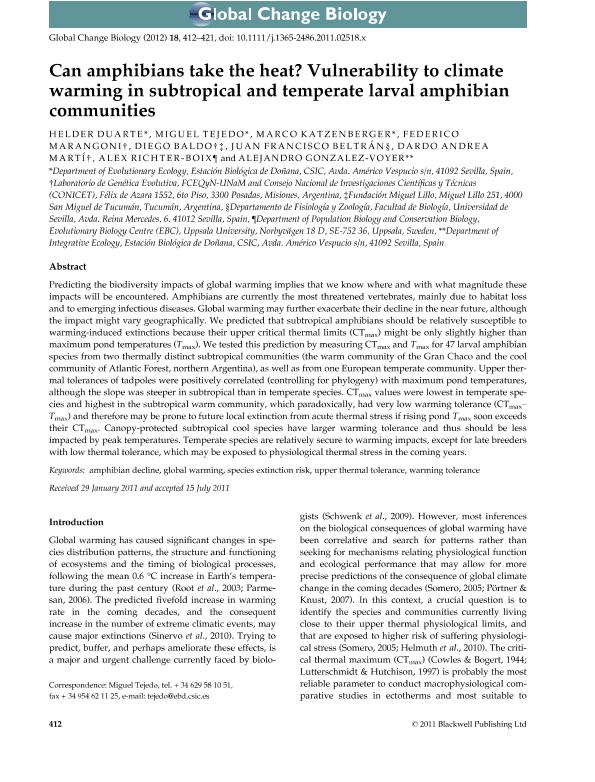Mostrar el registro sencillo del ítem
dc.contributor.author
Duarte, Helder
dc.contributor.author
Tejedo, Miguel

dc.contributor.author
Katzenberger, Marcos
dc.contributor.author
Marangoni, Federico

dc.contributor.author
Baldo, Juan Diego

dc.contributor.author
Beltrán, Juan Francisco
dc.contributor.author
Marti, Dardo Andrea

dc.contributor.author
Richter Boix, Alex
dc.contributor.author
Gonzalez Voyer, Alex
dc.date.available
2019-12-27T03:24:35Z
dc.date.issued
2012-02
dc.identifier.citation
Duarte, Helder; Tejedo, Miguel; Katzenberger, Marcos; Marangoni, Federico; Baldo, Juan Diego; et al.; Can amphibians take the heat? Vulnerability to climate warming in subtropical and temperate larval amphibian communities; Wiley Blackwell Publishing, Inc; Global Change Biology; 18; 2; 2-2012; 412-421
dc.identifier.issn
1354-1013
dc.identifier.uri
http://hdl.handle.net/11336/93023
dc.description.abstract
Predicting the biodiversity impacts of global warming implies that we know where and with what magnitude these impacts will be encountered. Amphibians are currently the most threatened vertebrates, mainly due to habitat loss and to emerging infectious diseases. Global warming may further exacerbate their decline in the near future, although the impact might vary geographically. We predicted that subtropical amphibians should be relatively susceptible to warming-induced extinctions because their upper critical thermal limits (CT max) might be only slightly higher than maximum pond temperatures (T max). We tested this prediction by measuring CT max and T max for 47 larval amphibian species from two thermally distinct subtropical communities (the warm community of the Gran Chaco and the cool community of Atlantic Forest, northern Argentina), as well as from one European temperate community. Upper thermal tolerances of tadpoles were positively correlated (controlling for phylogeny) with maximum pond temperatures, although the slope was steeper in subtropical than in temperate species. CT max values were lowest in temperate species and highest in the subtropical warm community, which paradoxically, had very low warming tolerance (CT max-T max) and therefore may be prone to future local extinction from acute thermal stress if rising pond T max soon exceeds their CT max. Canopy-protected subtropical cool species have larger warming tolerance and thus should be less impacted by peak temperatures. Temperate species are relatively secure to warming impacts, except for late breeders with low thermal tolerance, which may be exposed to physiological thermal stress in the coming years.
dc.format
application/pdf
dc.language.iso
eng
dc.publisher
Wiley Blackwell Publishing, Inc

dc.rights
info:eu-repo/semantics/openAccess
dc.rights.uri
https://creativecommons.org/licenses/by-nc/2.5/ar/
dc.subject
AMPHIBIAN DECLINE
dc.subject
GLOBAL WARMING
dc.subject
SPECIES EXTINCTION RISK
dc.subject
UPPER THERMAL TOLERANCE
dc.subject
WARMING TOLERANCE
dc.subject.classification
Ecología

dc.subject.classification
Ciencias Biológicas

dc.subject.classification
CIENCIAS NATURALES Y EXACTAS

dc.title
Can amphibians take the heat? Vulnerability to climate warming in subtropical and temperate larval amphibian communities
dc.type
info:eu-repo/semantics/article
dc.type
info:ar-repo/semantics/artículo
dc.type
info:eu-repo/semantics/publishedVersion
dc.date.updated
2019-12-11T14:36:40Z
dc.journal.volume
18
dc.journal.number
2
dc.journal.pagination
412-421
dc.journal.pais
Reino Unido

dc.journal.ciudad
Londres
dc.description.fil
Fil: Duarte, Helder. Consejo Superior de Investigaciones Científicas. Estación Biológica de Doñana; España
dc.description.fil
Fil: Tejedo, Miguel. Consejo Superior de Investigaciones Científicas. Estación Biológica de Doñana; España
dc.description.fil
Fil: Katzenberger, Marcos. Consejo Superior de Investigaciones Científicas. Estación Biológica de Doñana; España
dc.description.fil
Fil: Marangoni, Federico. Consejo Nacional de Investigaciones Científicas y Técnicas. Centro Científico Tecnológico Conicet - Nordeste; Argentina. Universidad Nacional de Misiones. Facultad de Humanidades y Ciencias Sociales. Departamento de Genética. Laboratorio de Genética Evolutiva y Molecular; Argentina
dc.description.fil
Fil: Baldo, Juan Diego. Consejo Nacional de Investigaciones Científicas y Técnicas. Centro Científico Tecnológico Conicet - Nordeste; Argentina. Universidad Nacional de Misiones. Facultad de Humanidades y Ciencias Sociales. Departamento de Genética. Laboratorio de Genética Evolutiva y Molecular; Argentina. Fundación Miguel Lillo; Argentina
dc.description.fil
Fil: Beltrán, Juan Francisco. Universidad de Sevilla; España
dc.description.fil
Fil: Marti, Dardo Andrea. Consejo Nacional de Investigaciones Científicas y Técnicas. Centro Científico Tecnológico Conicet - Nordeste; Argentina. Universidad Nacional de Misiones. Facultad de Humanidades y Ciencias Sociales. Departamento de Genética. Laboratorio de Genética Evolutiva y Molecular; Argentina
dc.description.fil
Fil: Richter Boix, Alex. Uppsala University. Evolutionary Biology Centre; Suecia
dc.description.fil
Fil: Gonzalez Voyer, Alex. Consejo Superior de Investigaciones Científicas. Estación Biológica de Doñana; España
dc.journal.title
Global Change Biology

dc.relation.alternativeid
info:eu-repo/semantics/altIdentifier/doi/http://dx.doi.org/10.1111/j.1365-2486.2011.02518.x
dc.relation.alternativeid
info:eu-repo/semantics/altIdentifier/url/https://onlinelibrary.wiley.com/doi/abs/10.1111/j.1365-2486.2011.02518.x
Archivos asociados
